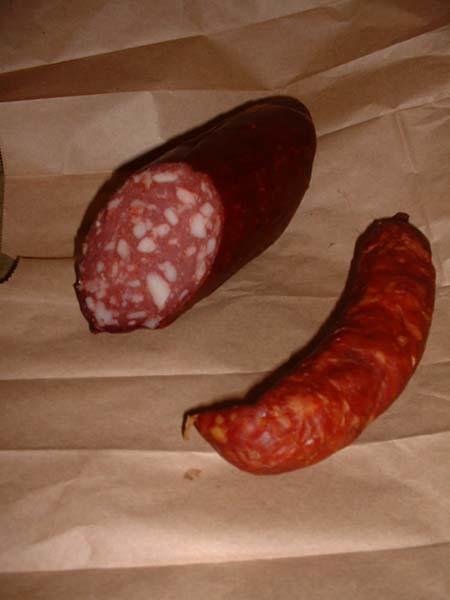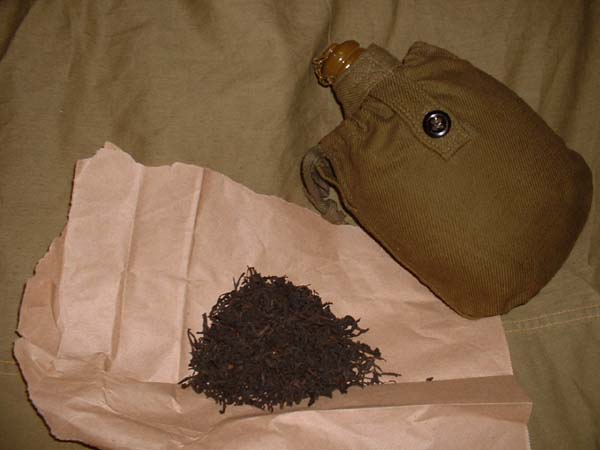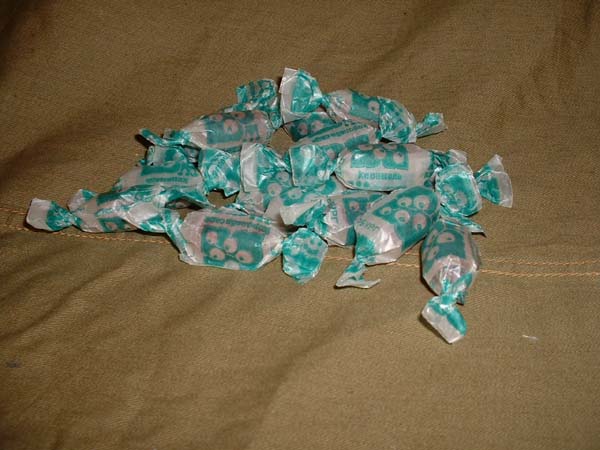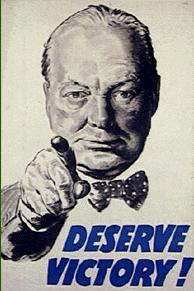Russian Rations of The Great Patriotic War
By Knackerstaff
When the Soviet Union invaded Poland with their unlikely ally Germany, Russian food
supply in general for both civilian and military use was in decline, and had been so for the past decade. Not withstanding
this, there existed quite well designed regulations pertaining to soldiers' rations, the delivery and quality of foodstuffs,
and what types of reserve rations were to be issued.
An example of this can be found in the "US Army Handbook on USSR Military Forces",
where a soldiers ration is listed as consisting of (our comments are in parenthesis):
Bread (Gray or black rye varieties--pictures to follow) almost 2 pounds in winter,
1.75 pounds in summer
Wheat flour 0.7 oz
Grits about 5 oz
Macaroni, or egg noodles 1 oz (quite popular with the various peoples of the
USSR)
Meat 5.25 oz (either fresh or preserved)
Fish 3.5 oz (either fresh or preserved)
Soy Flour 0.5 oz
Fats lard, chicken fat or bacon grease--About 1 oz
Vegetable oil 0.7 oz
Sugar 1.22 oz
Tea 0.035 oz
Salt 1.05 oz
Vegetables 12.7 oz (or 5.74 oz of additional grits for ease of transport)
Tomato Paste 0.21 oz
Spices 0.01 oz
Tobacco 0.7 oz
The Emergency ration consisted of:
Biscuits (tinned or sealed cardboard/paper wrapper) 17.5 oz
Concentrated food--Course I (2.6 oz of Instant soup or enriched Biscuits)
Concentrated food--Course II (7.0 oz More of the same---Where available
after late 1942, Lend-Lease Tins or even some pre-packaged ration items, such as British Biscuits or dripping spread)
Smoked Sausages 3.5 oz (substituted by lard, fish conserves, bacon)
Sugar 1.2 oz
Tea 0.07 oz
Salt 0.35 oz
Meal and Ration delivery/Field Kitchens:
Planning called for hot meals in the morning and the evening, but this was
likely to only be a rare occurrence, especially when war with Germany erupted.
From 1941 through mid-1942, Soviet troops fought on minimal rations, and
local procurement was the norm. Greatly prized were captured German rations, and often times raids would be planned around
capture of supply dumps specifically containing foodstuffs.
During the initial year of the war, many times regular soldiers would receive
regular deliveries of food stuffs as likely from partisans operating behind German lines (but in a zone that was now able
to produce limited amounts of food under the watchful eyes of the Wehrmacht), as through regular Red Army supply channels.
Later in the war, of course, the reverse happened, as the Germans became more organized in their systematic stripping of resources
from the occupied territories.
Reenactment rations:
The aspiring Frontovik fighting for the Rodina should keep the following rations
in mind when setting out to fight off the German invasion:
1941-mid 1942:
Virtually no help from the allies-France has fallen, Britain is besieged,
and America is sending very infrequent "aid and solidarity" packages, which are meant for use in hospitals.
Regular Russian supply channels are virtually non-existent, and foodstuffs
are at a premium. Even though field kitchens try to churn out a hot meal, tea or some form of cereal or soup, even where this
is available, it is just not enough.
This means that the rations carried by a Soviet Soldier of the day is most
likely a piece of Bread, remnants of the "Untouchable Supply" (if these ever reached his unit in the first place), and possibly
some vegetables, a smear of lard in the mess tin, and any other locally obtained items.

|
| Ivan's
portable meat ration-Note the wrapper |
FOR THE REENACTOR THIS MEANS...
Rye bread: (not the soft, sliced
stuff from the supermarket--Go to a Deli and get a loaf of heavy or dark rye that is not sliced--Day old? Even Better!).
Small red or white potatoes (No big baking potatoes -Sorry Tovarish!)
Cabbage: Both Red or Green varieties
Carry hard-boiled Eggs
Hard Sausage or smoked bacon
(Not half a pig--a few ounces wrapped in paper)
A small paper bag of macaroni (the elbow kind) or grits
Apples, hard pears, prunes
Sunflower seeds (wrapped in a handkerchief)
Fish, tinned or dried. Tinned varieties
can be Sprats, Mackerel or Herring
Tea: Generally a bit of loose-leaf
tea. Early in the war only very coarse stuff was available --Check out the picture at the bottom of this paragraph!
Salt: A small amount of Salt twisted
into some brown or wax paper was often encountered
Sugar: An ounce or so of plain sugar
wrapped in paper or wax paper, or a piece or two of hard lump candy
Tobacco: The only way you should
be able to tell your smoking tobacco from your tea is by boiling it--same large loose leaves as the tea. Check in Smoke shops
for coarse hand-rolling tobacco. Cigarettes were virtually unheard of.
Gutsy? Make nettle soup, plenty of recipes online!
If sophisticated: Latrine paper(Russian newsprint or leaflets)
No, not too many 13-stone front fighting troops during that part of the war!

|
| Tea
for the Troops, again in Brown Paper! |
Mid 1942-Late 1943
With the stronger involvement of the British (trying to persuade Stalin that the
time for a second front has not come yet), food stuffs of British or Commonwealth origin start filtering through. These initially
consist of shipments of tinned meats, such as luncheon loaves or Brazilian bully beef, biscuits and compressed soups/broth
cubes. Secondly, Britain is also delivering older U.S. made supplies to Russia, such as chocolate bars during the Winter of
1942.
With limited resources, the Soviet military is in many cases not re-labeling the
supplies at all, but is merely passing them down to the troops, which initially leads to some confusion what is what, as the
British also had the unnerving habit of either color coding or simply leaving un-marked tinned goods destined for specific
ration packs. To avoid misdistribution, Soviet planners decide to begin applying small paper slips with one-word description
of the contents to most tins, even to those were labels exist. Thus, it was not unusual to find British meat tins with a small
buff paper label pasted on the front declaring its contents in Russian. Oddly enough, much of the tea supplied by the British
actually came in small cello bags for shelf-life, yet the Soviets decided to expend effort and materials on this by boxing
the 1.75 ounce bags in small cardboard boxes labeled "Tea".
This must truly been decided upon back at the institute on the all the efficiency
experts were called to the Kremlin for some "information exchange" with Comrade Stalin!
FOR THE REENACTOR THIS MEANS
In addition to the early war items, the following would be appropriate:
Tinned Beets--200-gram to 400-gram
tins (7-14 ounces) with period labels. These were one of the few things canned throughout the war.
British meat tins--Bully Beef or
Luncheon meat, along with the various colored British meat and fish tins (6 ounce ham, chicken and fish round tins as found
in British ration sets)
Broth cubes--These were larger and
drier than your average bullion cube. Ethnic stores carry them, or Knacker Squaddies actually has a very good replica made
to their specs.
British or British over-wrapped Chocolate. These include the small .75 oz
bars and American Hershey and Nestle brand bars in British outer wrappers or morale-support Pink wrappers
Sweet Biscuits--Various Russian-made
biscuits appear in small packages which are handed out as a morale-support item, and, obviously to help with fending off cold
temperatures.
Barley--Small pre-packaged rations
of Barley are issued to troops in front-line units. This was an essential item for squad-level preparation of food in areas
where no hot rations of other kinds could be provided, either due to remoteness or enemy action
Sugar tablets ("Cubes") in wrappersAnother
British Lend-Lease Item that fast became a favorite of troops. Both regular (white) sugar tablets and molasses sugar (brown)
tablets were provided.
Sweets--Both Western ally supplied
sweets and Russias "homegrown" varieties came to the front in larger numbers. While the western allies generally had military
pre-packs, Russian candy (normally more properly called a confection, as much of these were chocolate truffle or filled miniature
bars) came in wax wrapped varieties similar to pre-war products, and no opportunity to hand these out for propaganda purposes
was missed. Check your local ethnic store, or use Brit/US candy repros.
Tea in 50 gram (1.75 oz) pre-packs.
This British morale builder was most appreciated and jealously guarded by the frontovik. Both small boxes and printed envelope
varieties existed, both having a cellophane or wax-paper liner. If fresh out of vintage boxes, wrap about a cigarette pack
sized amount of leaf tea in brown paper.

|
| Domestic
Hard Candy. Note the wax paper wrap! |
1943-VJ Day
As the Red Army began turning the tables on the Germans, a vigorous program of agricultural
assessment, combined with an aggressive restructuring of the supply system led to somewhat improved conditions. Of course,
foreign lend-lease aid was now streaming in large quantities, especially from the US. Even though many Russians called American
Meats like SpamŽ "Second Front" to express their frustration with the delays in invading Fortress Europe in the west, all
Soviet soldiers and politicians agreed that these shipments were a strong contribution to the war effort.
Russia even began a large-scale production of their own tinned meat rations, tinned
vegetables and more varieties of tinned fish. After mid 1943, even condensed or evaporated milk started reaching the front
lines again (albeit much of it from British or US Stores).
FOR THE REENACTOR THIS MEANS...
In addition to the early war items, the following would be appropriate:
Tinned meats--(Russian labeled,
or US/British with small over-stickers). If you are partial to Beef or Pork in their own juice, look for "Tushonka", Russia's
saucy "Spam".
More variety in tinned vegetables
Occasionally, even complete US operational rations like K-Rations can be used
Tinned Milk--with Russian or British
repro labels
One more hint about Russian Army Bread rations:
To this day, the Russian Army divides bread in an odd manner
As it comes in large loaves, two men are involved. One cuts the bread, facing away
from the troops. The other stands with his back to him. When a piece is cut, the rear man shouts out "Who gets this piece?",
while the second man calls out a name...
Thought you may like another touch of authenticity...Grandarse was actually witness
to this strange ritual serving as German liaison to the Russian units departing the former East Germany in 1990!

